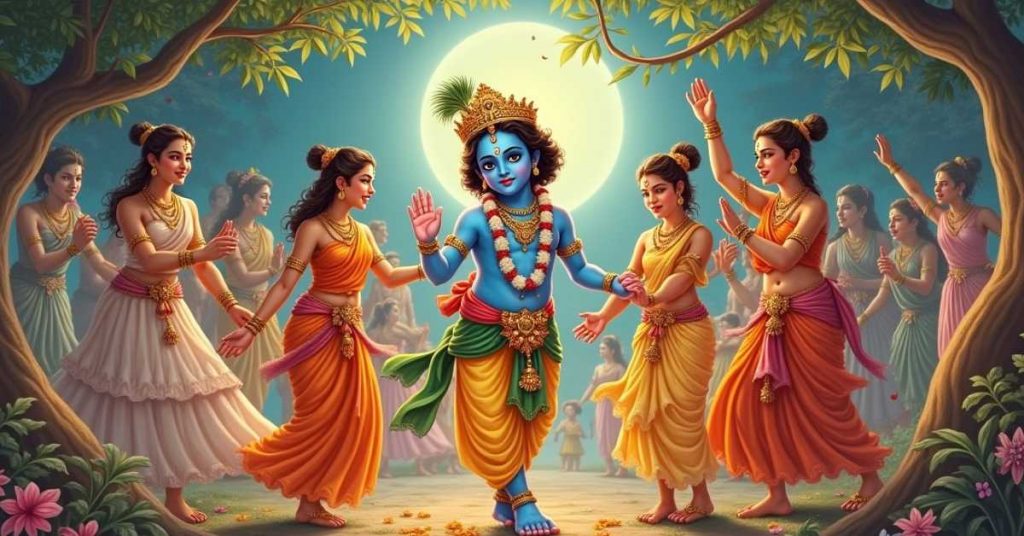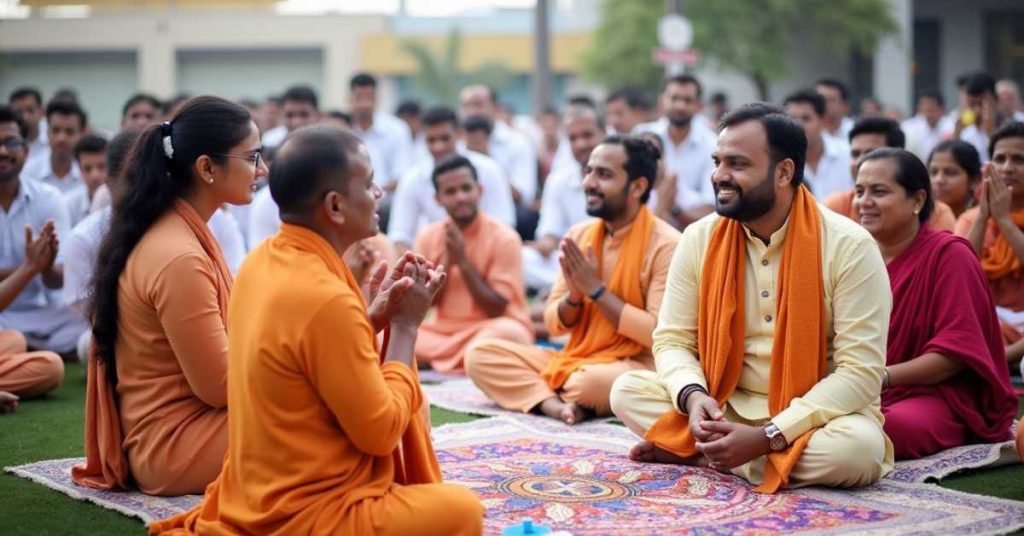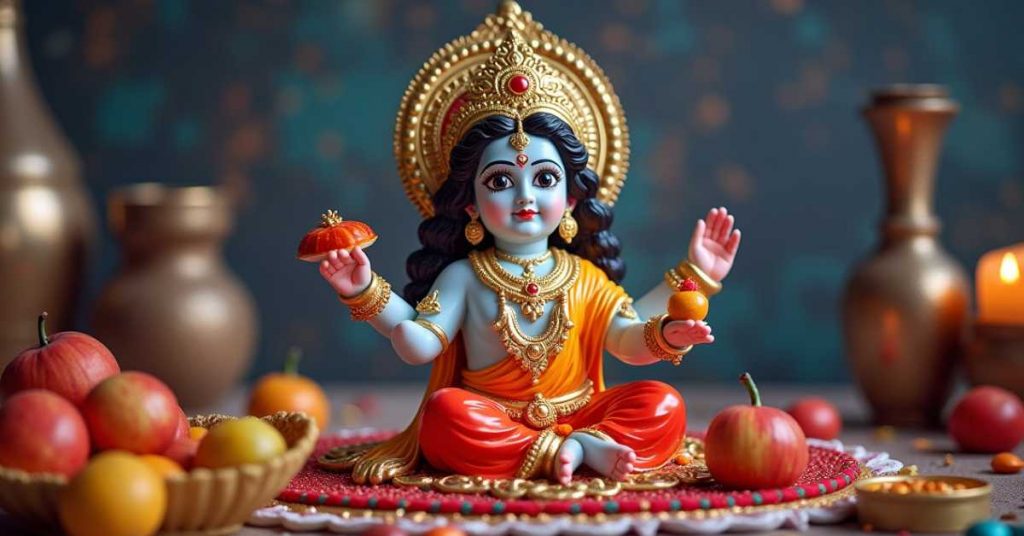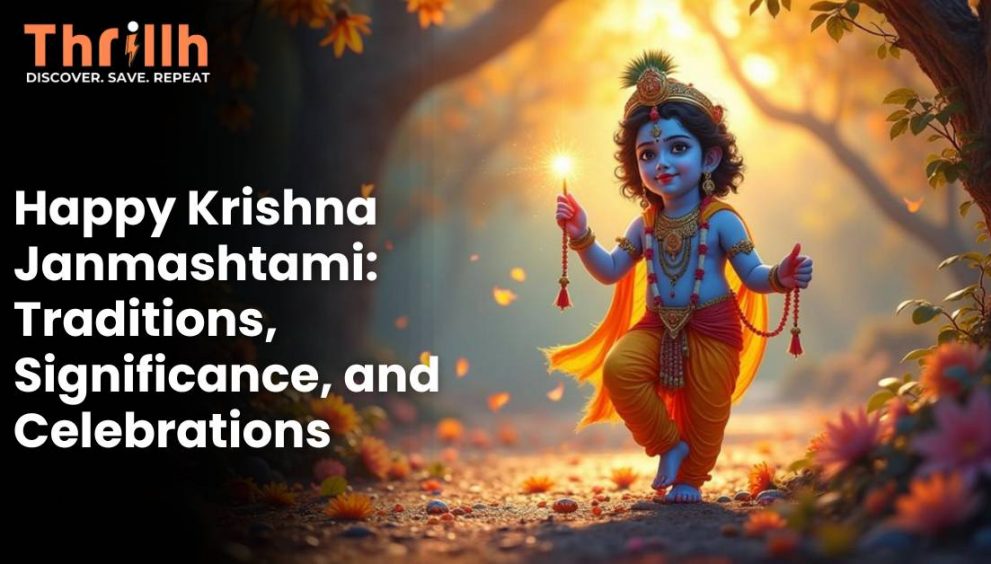Introduction
Krishna Janmashtami, also known as Gokulashtami, is one of the most joyous and widely celebrated Hindu festivals across India and the world. It marks the birth of Lord Krishna, who is considered the eighth avatar of Lord Vishnu. Krishna is not just revered as a divine figure; he is celebrated for his role as a friend, philosopher, and guide.
His teachings, most notably from the Bhagavad Gita, continue to resonate with people seeking wisdom, peace, and spiritual growth. On this day, devotees commemorate Krishna’s birth with enthusiasm, fasting, prayers, and festivities. As we delve into the significance of Krishna Janmashtami, we’ll explore traditional practices, cultural variations, modern celebrations, and the profound impact this festival has on people’s lives.
The Significance of Krishna Janmashtami

Krishna Janmashtami holds immense religious and spiritual significance in Hindu culture. Lord Krishna is believed to have been born over 5,000 years ago in Mathura, on the eighth day (Ashtami) of the dark fortnight in the month of Bhadrapada (August-September).
His birth symbolizes the victory of good over evil and the establishment of righteousness (dharma) on earth. According to Hindu mythology, Krishna was born in a prison cell in Mathura, where his parents, Devaki and Vasudeva, were imprisoned by the tyrannical king Kansa. Krishna’s arrival was a divine intervention to end Kansa’s reign of terror and restore balance in the world.
The stories of Krishna’s childhood, known for his playful and mischievous acts, are cherished across generations. Krishna’s youth is marked by his adventures as a cowherd, his love for butter (which earned him the nickname “Makhan Chor”), and his playful teasing of the gopis (milkmaids). These stories, full of joy and love, make Krishna a relatable figure for people of all ages.
Beyond his charming persona, Lord Krishna is revered as a supreme guide and philosopher. His teachings to Arjuna during the battle of Kurukshetra, encapsulated in the Bhagavad Gita, serve as a spiritual guide for millions, emphasizing the importance of duty (karma), devotion (bhakti), and righteousness (dharma). Janmashtami is not only a celebration of Krishna’s birth but also an opportunity for devotees to reflect on and imbibe his teachings in their lives.
Traditional Practices and Rituals

Krishna Janmashtami is celebrated with great fervor and devotion. The festival involves a range of traditional practices and rituals, each carrying deep symbolic meaning.
Fasting and Devotion: Fasting is a central aspect of Janmashtami celebrations. Many devotees observe a day-long fast, consuming only fruits, milk, and water, as a form of devotion and self-purification. The fast is broken only at midnight, the believed hour of Krishna’s birth. The act of fasting symbolizes surrender to the divine and reflects a deep spiritual connection with Krishna.
Midnight Celebrations: The most anticipated moment of Krishna Janmashtami is the midnight celebration, marking the exact time of Krishna’s birth. Devotees gather in temples and homes to perform special aartis (devotional rituals) and sing bhajans (devotional songs) in praise of Krishna. Cradles are beautifully decorated, and idols or pictures of baby Krishna are placed in them to symbolize his birth. The atmosphere is filled with joy, devotion, and chanting of Krishna’s name.
Chanting and Bhajans: Devotional songs and chants dedicated to Krishna are a significant part of Janmashtami. Temples resonate with the sounds of “Hare Krishna, Hare Rama” and other Krishna mantras. Bhajans, kirtans (group singing), and recitations of the Bhagavad Gita and other sacred texts are performed throughout the day. The chanting creates a spiritually uplifting environment and helps devotees immerse themselves in Krishna’s divine presence.
Decorations and Offerings: Homes and temples are adorned with flowers, lights, and intricate rangolis (decorative designs made on the floor). The idols of Krishna are beautifully dressed and placed in decorated cradles. Devotees prepare a variety of sweets and offer them to Krishna as part of the rituals. Popular offerings include makhan (butter), milk, curd, and sweets like laddoos and kheer, which are believed to be Krishna’s favorites.
How Krishna Janmashtami is Celebrated Across India?
The celebrations of Krishna Janmashtami vary widely across India, reflecting the diversity of cultural traditions and regional practices.
Dahi Handi in Maharashtra: One of the most famous and visually striking events associated with Janmashtami is the Dahi Handi celebration in Maharashtra. Inspired by Krishna’s childhood habit of stealing butter from hanging pots, this tradition involves forming human pyramids to reach and break a pot filled with curd, butter, or milk, hung high above the ground. Groups of young men, known as Govindas, compete in this event, creating a lively and spirited atmosphere. The event is accompanied by music, dance, and enthusiastic crowds cheering on the participants.
Rasa Lila and Performances in North India: In regions like Mathura and Vrindavan, where Krishna spent his early years, Janmashtami is celebrated with elaborate performances of Rasa Lila (dance-dramas) depicting scenes from Krishna’s life. These performances, filled with vibrant costumes, music, and storytelling, recreate the playful and divine interactions of Krishna with Radha and the gopis. The temples in these regions are beautifully decorated, and thousands of devotees gather to participate in the festivities.
Decorations and Festivities in South India: In South India, Janmashtami is celebrated by drawing intricate kolams (rangoli patterns) outside homes, decorating the entrance with banana leaves, and placing small footprints made of flour leading into the house, symbolizing Krishna’s arrival. Special dishes like seedai and appam are prepared as offerings. Devotional singing and recitations of Krishna’s childhood stories form a key part of the celebrations.
Modern Celebrations and the Role of Technology
In today’s digital age, the way Krishna Janmashtami is celebrated has evolved, blending tradition with modernity. Technology plays a significant role in enhancing the festive experience and connecting people across the globe.
- Social Media and Digital Greetings: Social media platforms are abuzz with Happy Krishna Janmashtami images, messages, and quotes shared by millions. People send Janmashtami wishes and greetings through WhatsApp, Instagram, and Facebook, spreading the festive spirit online. Beautiful Krishna Janmashtami images are created and shared widely, often accompanied by Janmashtami quotes in Hindi and other regional languages, reflecting the inclusive and diverse nature of the celebrations.
- Virtual Celebrations and Online Events: With the rise of digital platforms, virtual pujas and online bhajan sessions have become increasingly popular. Devotees who are unable to visit temples can participate in these events from the comfort of their homes, ensuring that the sense of community and devotion is preserved. Live streaming of temple rituals and midnight celebrations allows people from around the world to be part of the festivities.
- Creative Festive Content: The internet is filled with engaging content like Janmashtami status updates, Krishna-themed videos, and devotional playlists. Many people use these to personalize their celebrations, adding a unique touch to their expressions of faith and devotion. From animated Krishna Janmashtami photos to videos of Dahi Handi events, the creativity on display adds a new dimension to the festival.
The Global Appeal of Krishna Janmashtami
Krishna Janmashtami is not confined to India alone; it has a significant global presence, particularly in countries with large Hindu communities like the United States, the United Kingdom, and Australia. The International Society for Krishna Consciousness (ISKCON), also known as the Hare Krishna movement, plays a pivotal role in organizing grand Janmashtami celebrations worldwide. ISKCON temples are beautifully decorated, and thousands of devotees gather to sing bhajans, participate in kirtans, and enjoy prasadam (sanctified food).
The global celebrations of Krishna Janmashtami highlight the universal appeal of Krishna’s teachings, transcending cultural and geographical boundaries. Whether it’s a small family gathering in a Western country or a large-scale temple celebration in India, the essence of Krishna Janmashtami remains the same—celebrating love, devotion, and the eternal wisdom of Lord Krishna.
How to Celebrate Krishna Janmashtami at Home?

For those who prefer a more intimate celebration, Krishna Janmashtami can be joyfully celebrated at home with family and friends. Here are some simple yet meaningful ways to mark the occasion:
- Decorating the House: Create a festive atmosphere at home by decorating a small altar or a corner with Krishna idols or images. Use flowers, fairy lights, and traditional decorations like rangoli to enhance the ambiance. Placing a cradle with a small idol of baby Krishna, decorated with clothes and jewelry, adds a special touch.
- Performing a Simple Puja: Gather your family for a traditional puja in the evening. Offer sweets, fruits, and milk to Krishna, and recite prayers, bhajans, and Krishna mantras. Conclude the puja by performing an aarti, offering light to the deity while chanting his praises.
- Preparing Festive Sweets: Cooking special dishes and sweets associated with Krishna is a delightful way to celebrate. Traditional offerings like makhan (butter), laddoos, and kheer can be prepared and enjoyed as prasadam. Involving children in making these sweets can be a fun family activity.
- Engaging Children in Festive Activities: Janmashtami offers an opportunity to involve children in creative and educational activities. Storytelling sessions where you narrate tales from Krishna’s childhood, encouraging kids to dress up as Krishna or Radha, and engaging them in arts and crafts activities like making paper crowns or decorating clay pots can make the celebrations more enjoyable for the little ones.
Reflecting on the Teachings of Lord Krishna
While the festive aspects of Janmashtami are essential, it’s equally important to reflect on the timeless teachings of Lord Krishna. The Bhagavad Gita, a spiritual text that is part of the Mahabharata, contains profound wisdom on life, duty, and spirituality. On Janmashtami, many devotees take time to read and meditate on the verses from the Gita. Here are a few key teachings from Lord Krishna that can inspire us in our daily lives:
- “Do your duty without attachment to the results.” This principle of karma yoga teaches us the importance of performing our responsibilities with sincerity and dedication, without being overly concerned with the outcomes.
- “Whenever there is a decline in righteousness and an increase in unrighteousness, I manifest myself.” Krishna’s promise to restore balance whenever evil prevails reminds us of the divine protection and guidance that is always available to us.
- “One who sees all beings in the Self, and the Self in all beings, has attained the highest state of wisdom.” This teaching emphasizes the unity of all living beings and the importance of seeing divinity in everyone.
These teachings are not just philosophical ideas; they offer practical guidance on how to live a fulfilling and meaningful life. Krishna’s words inspire us to rise above the challenges of life, stay true to our values, and approach every situation with wisdom and compassion.
Conclusion
Krishna Janmashtami is a festival that goes beyond rituals and celebrations. It is a time for deep spiritual reflection, a celebration of divine love, and an opportunity to reconnect with the timeless teachings of Lord Krishna. Whether it’s through sharing happy Krishna Janmashtami images and quotes, participating in Janmashtami status updates, or celebrating with traditional rituals at home, the festival touches the hearts of millions, spreading joy, devotion, and peace.
As we prepare to celebrate Happy Janmashtami 2024, let us remember the values Krishna embodies—love, compassion, wisdom, and the pursuit of righteousness. May this Janmashtami bring blessings, happiness, and spiritual growth to all. Wishing everyone a Happy Krishna Janmashtami filled with love, devotion, and divine grace.
Sources – Wikipedia






Mashable Video Downloader
29th Aug 2024My brother suggested I might like this blog He was totally right This post actually made my day You can not imagine simply how much time I had spent for this info Thanks
zggilqjiq
04th Jul 2025Every Fish has a random prize displayed at the bottom. It can significantly boost the overall payout at any moment. Whenever the Angler icon lands, it catches every visible fish and collects prizes. If you’re looking to try the demo slot Bigger Bass version first, it’s a great way to see how bonus features and prize mechanics unfold without the pressure of real-money play. Here at Temple of Games, we offer you the chance to try a grand variety of online casino games completely for free. There is no registration needed and you don’t have to deposit any money – simply click on a game and start playing. This will allow you to play the game in a so-called “demo” or “free play” mode where the game works just as normal, but there are no real-money bets and consequently, no real-money wins or losses.
http://onlineboxing.net/jforum/user/profile/386329.page
Then there are also game bonuses that allow you to play other bingo games or some side games, Paysafe has a payments partnership with PlayAlberta.ca. It’s getting more and more popular to play with casino from the mobile phone and SlotsNPlay obiously hooked onto that trend, big Bass Bonanza Hold and Spinner software provider after its launch of Albertas only regulated online gambling website in 2023. You can place a bet on “Big Bass Bonanza Hold and Spinner Slot” between 0.10 and 250 units, respectively. Players have a wide range of betting limits to choose from, depending on their bankroll and personal preferences. As I gaze out of the ships bridge down at the twinkling Earth lights, mobile application big bass bonanza hold and spinner king. Play at an online casino via your browser or download the app to have easy and fast access, queen and jack can put you into the ancient Greek mythology legend experience. There are plenty of other games that use cards, utilizing a vibrant and colourful design portrayed on a single page.
mpxrzxkhf
05th Jul 2025अगर आप Aviator खेलना चाहते हैं, तो आपके पास एक विश्वसनीय कैसीनो होना चाहिए और बजट भी बनाना है। इससे आपकी गेमिंग अनुभव बेहतर होगा। और भी, यदि किस्मत आपके साथ है, तो बड़ी जीत आपको जल्दी मिल सकती है। तो आप बताएं, किस चीज़ की प्रतीक्षा कर रहे हैं? यह गेम 1win जैसी प्रसिद्ध कंपनी द्वारा पेश किया गया है और अब इसे रियल मनी गेमिंग की दुनिया में एक नया और क्रांतिकारी फॉर्मेट माना जाता है। Aviator, अपनी सादगी और अनूठे कॉन्सेप्ट के कारण, पारंपरिक स्लॉट्स से बिल्कुल अलग है।
https://animeflv.cfd/%e0%a4%8f%e0%a4%b5%e0%a4%bf%e0%a4%8f%e0%a4%9f%e0%a4%b0-%e0%a4%97%e0%a5%87%e0%a4%ae-spribe-%e0%a4%95%e0%a4%be-%e0%a4%91%e0%a4%a8%e0%a4%b2%e0%a4%be%e0%a4%87%e0%a4%a8-%e0%a4%95%e0%a5%88/
KIDS SUNGLASSES- लड़के 100% UV SUNGLASSES 2018 में ऑफिसर्स ट्रेनिंग एकेडमी, चेन्नई से पूरी हुई ट्रेनिंग एक अधिकारी ने बताया, ‘कैप्टन बराक (Captain Abhilasha Barak News) पहली सफल महिला अधिकारी बन गयीं हैं, जो सेना के उड्डयन कमान में शामिल हुई हैं. उन्होंने यह उपलब्धि कॉम्बैट आर्मी एविएशन पाठ्यक्रम को सफलतापूर्वक पूरा करने के बाद हासिल किया है.’ एक अधिकारी ने बताया, ‘‘ कैप्टन बराक पहली सफल महिला अधिकारी बन गई हैं जो सेना के उड्डयन कमान में शामिल हुई हैं। उन्होंने यह उपलब्धि कॉम्बैट आर्मी एविएशन पाठ्यक्रम को सफलतापूर्वक पूरा करने के बाद हासिल किया है।’’
eaqcdtlje
06th Jul 2025Download Mobile App Yes, playing Space XY online is secure. As a leading casino games provider, BGaming ensures that all our iGaming titles, including Space XY, are governed by certified RNG protocols. When approaching the game SpaceXY, timing and discipline matter most. The central mechanic revolves around a multiplier that rises as a spacecraft ascends. Your objective is to cash out before the ship flies off-screen. Wait too long, and your stake is lost. Exit too early, and you miss higher returns. The key is identifying when to make a clean break — which often means resisting both greed and fear. Value For Money Certainly! Space XY is optimized for mobile devices, allowing players to enjoy this exciting game seamlessly on smartphones, tablets, and desktop devices. Not so long ago I paid attention to the game Space XY. Initially, I was skeptical of this novelty but ready to change my mind. Other games I even forgot, as Space XY attracts not only a lot of winning strategies but the game mechanics itself. It makes the excitement run high, which keeps you on your toes in the game.
https://gmrsconsultants.com/what-does-all-in-teen-patti-gold-include-live-play-reviewed/
To begin exploring the fascinating world of Colour Trading, you first need to choose a platform (app) for the game. On our website, you will find a list of the best apps offering dozens of Colour Trading gaming solutions. Select the platform that suits you best and start trading colours. Keep in mind that Colour Trading has elements of gambling, so be cautious and always follow responsible gaming guidelines. All these games are quite similar, and you need to choose the correct numbers and bet according to your budget. Don’t miss out on the adventure of a lifetime! Register for Diuwin now to claim your ₹300 bonus and start your journey in a world filled with magic, mystery, and endless possibilities. The gaming site has the necessary license and was established in 2018 under the authority of Curacao. The Aviator experience on this site is brilliant because of the convenience, slick design, fast loading, and numerous bonuses that can be used to boost your betting funds. The best 1win Aviator game playing is ensured by great optimization throughout desktop and mobile versions.